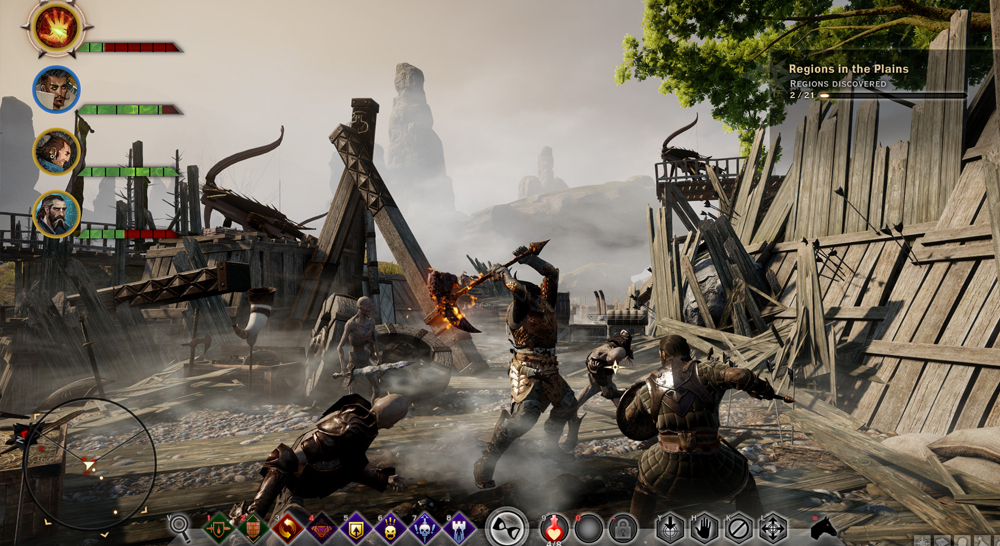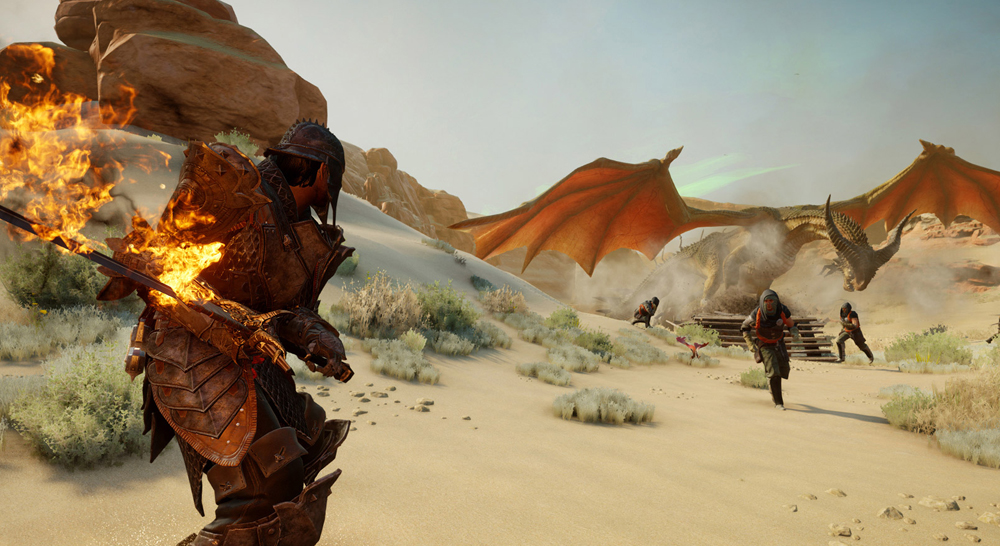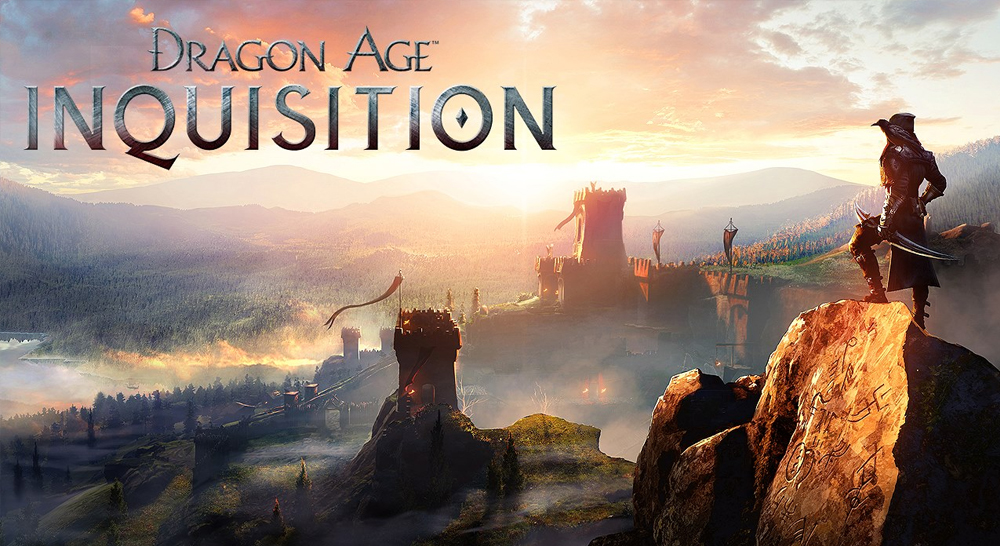Gameplay
 In Dragon Age: Inquisition, you aren’t just the leader of some merry band of adventurers, but the focal point of a sweeping, large-scale movement to bring reform and order to a land ripped apart by civil war and political strife. Literally, in a way, as interdimensional demon-spewing rifts are tearing holes in the sky across the world. Your organization has tons of tiny moving parts to manage, but major actions, such as scouting new regions and undertaking new story missions, require power – a central resource that’s doled out for doing nearly anything of note across Inquisition’s nine large areas. It’s a brilliant idea that gives purpose to all the side-questing and sightseeing by directly tying it to story progression.
In Dragon Age: Inquisition, you aren’t just the leader of some merry band of adventurers, but the focal point of a sweeping, large-scale movement to bring reform and order to a land ripped apart by civil war and political strife. Literally, in a way, as interdimensional demon-spewing rifts are tearing holes in the sky across the world. Your organization has tons of tiny moving parts to manage, but major actions, such as scouting new regions and undertaking new story missions, require power – a central resource that’s doled out for doing nearly anything of note across Inquisition’s nine large areas. It’s a brilliant idea that gives purpose to all the side-questing and sightseeing by directly tying it to story progression.
Some of Inquisition’s regions seemed restrictive, even corridor-like when I initially set foot in them, but they soon opened up into vast sandboxes. No matter how many demon-spawning rifts I closed, or hidden shards I found, I always felt like I was making tiny dents on the tip of an iceberg. That’s not to say it lacks a sense of progression; the way you start as a band of upstart rebels and grow into a highly influential martial and political force is one of Inquisition’s most satisfying traits. It’s just that the sheer volume of content borders on overwhelming. Thankfully, a handy quest map makes it easy to track each region’s content, which allowed me to focus my attention on a set goal… at least until wanderlust inevitably set in.
And boy, did it set in often. The diverse landscapes of Ferelden and Orlais strike a smart balance between open spaces and narrow, directed paths. Unclaimed keeps and unexplored ranges on the horizon kept tempting me away from my current story objective, while clearly marked pathways kept me from ever feeling truly lost. In fact, I never once felt like I’d hit a dead end, because you can barely walk in any direction for a minute without stumbling upon something to do – and amazingly, none of it ever feels like filler.
 That’s partly because of how good of a job Inquisition does of contextualizing its many pieces. Whether it’s with a well-delivered piece of dialogue or a smartly-written bit of supporting lore, every quest you undertake has an air of being something more important than the simple fetch or kill task it actually is. But better still, it all leads to tangible rewards through a series of well-designed crafting and progression systems that give Inquisition’s huge body of content the spine and structure required to keep me engaged. Completing a cursory task for a farmer may open up new mounts for you and your party to ride, and making the right conversation choices with a seemingly unimportant NPC might lead to empire-wide bonuses. You never know how even your smallest actions might impact your experience, which gives further purpose to all the scouring and scrapping you do out in the field.
That’s partly because of how good of a job Inquisition does of contextualizing its many pieces. Whether it’s with a well-delivered piece of dialogue or a smartly-written bit of supporting lore, every quest you undertake has an air of being something more important than the simple fetch or kill task it actually is. But better still, it all leads to tangible rewards through a series of well-designed crafting and progression systems that give Inquisition’s huge body of content the spine and structure required to keep me engaged. Completing a cursory task for a farmer may open up new mounts for you and your party to ride, and making the right conversation choices with a seemingly unimportant NPC might lead to empire-wide bonuses. You never know how even your smallest actions might impact your experience, which gives further purpose to all the scouring and scrapping you do out in the field.
Not that said scrapping needs much incentive beyond the excitement it provides. Inquisition’s new tactical view lets you pause and give orders at will from an overhead perspective, much like you could in Dragon Age: Origin on PC. It takes a little getting used to, especially when the camera decides to misbehave, but once you come to grips with it, it becomes a powerful tool for coordinating your party. You can hang back and set traps for over-zealous enemies, have your rogue creep along the edge of the battlefield to go for flanking bonuses, orchestrate explosive ability combos between party members, and much more. Inquisition successfully marries the measured approach of old-school BioWare games with the flashier, action-oriented approach of Dragon Age 2 and the later Mass Effect games. The result is combat that feels pleasingly punchy when controlled directly, and tactically sound when played like a puppeteer.
Like most BioWare games before it, Inquisition isn’t without its fair share of technical annoyances. Dialogue sequences would occasionally hang, interface elements would suddenly stop working, and sound would randomly cut out in the middle of battle. Most of these could be fixed with a quick reload, but those interruptions still took me out of the experience a little too often. A day-one patch is supposed to remedy many of these issues, but if you plan to play without updating, you’re in for a bumpy ride.
 Where Inquisition really stumbles, though, is in its story. It gets off to a vague start, and never really congeals. The Dragon Age universe is rich with impressively nuanced lore and socio-political intrigue, but Inquisition lacks the heart and pathos of BioWare’s best games. There are some interesting individual beats, but the how and why that’s supposed to connect them is all very tenuous. It’s a shame too, because all the main characters are well-written and acted – particularly Dorian, whose familial struggles provided some genuinely emotional moments. By the time the story reached its climax though, I cared about the people involved, but I had little connection to what was at stake, or Inquisition’s completely forgettable villain.
Where Inquisition really stumbles, though, is in its story. It gets off to a vague start, and never really congeals. The Dragon Age universe is rich with impressively nuanced lore and socio-political intrigue, but Inquisition lacks the heart and pathos of BioWare’s best games. There are some interesting individual beats, but the how and why that’s supposed to connect them is all very tenuous. It’s a shame too, because all the main characters are well-written and acted – particularly Dorian, whose familial struggles provided some genuinely emotional moments. By the time the story reached its climax though, I cared about the people involved, but I had little connection to what was at stake, or Inquisition’s completely forgettable villain.
Ultimately, the tale I was truly invested in was the one I carved out with not only the major story decisions I made, but where I spent my time, who I spent it with, and how I chose to run the Inquisition. In the war room, little mini-stories played out as I decided which of my advisors should handle different tasks, the outcomes changing depending on their aptitudes. In the the throne room I’d sit and pass judgement on those I’d brought to justice during previous quests. Who do I execute? Who do I exile? Who get’s a second chance? Combined with the excellent party banter, content like this ensured that my story remained interesting even after the curtain had fallen on the main campaign.
One more thing to do after finishing the campaign is the surprisingly good online co-op, which has you leveling a totally separate character up to plow through a variety of dungeons with friends. It leverages the campaign’s enjoyable combat, and even the full-featured crafting system to boot. It isn’t a primary reason to buy Inquisition by any means, but it does boost its already substantial replay value considerably without imposing itself on you if you just want to play single-player.

